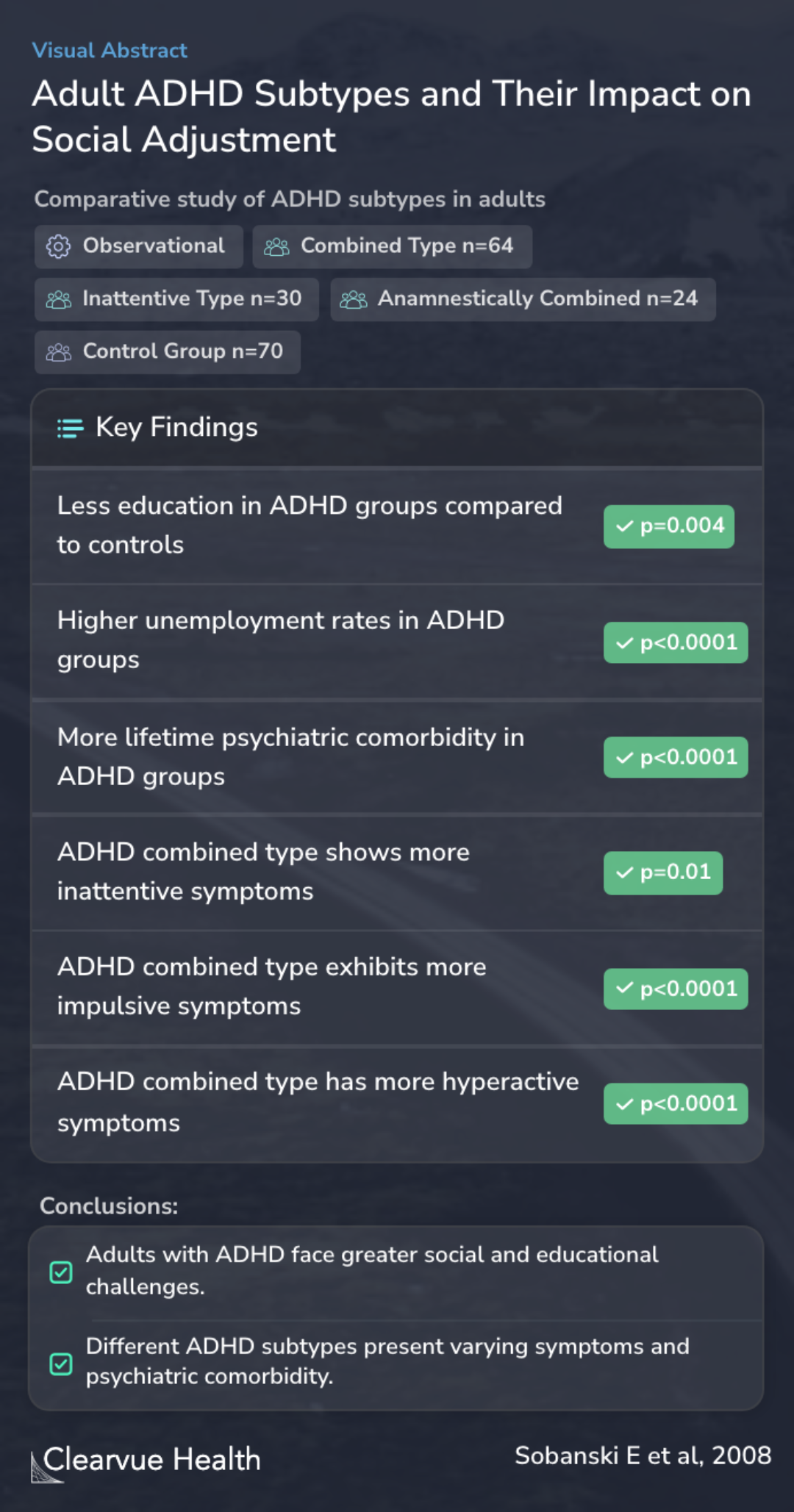Subtype differences in adults with attention-deficit/hyperactivity disorder (ADHD) with regard to ADHD-symptoms, psychiatric comorbidity and psychosocial adjustment
Adult ADHD Subtypes and Their Impact on Social Adjustment
Sobanski E, Brüggemann D, Alm B, Kern S, Philipsen A, Schmalzried H, Hesslinger B, Waschkowski H, Rietschel M

Objectives
The research aimed to understand the differences among adults with various types of ADHD. This focus is particularly notable because most previous studies on ADHD subtype differences have concentrated on children. Only two studies have delved into this topic in adults, and their results were not in agreement. This gap in research underlines the importance of this study.
Background: To date, nearly all research of subtype differences in ADHD has been performed in children and only two studies, with conflicting results, have covered this subject in adults with ADHD.
Methods
The study's methodology involved a thorough assessment of 118 adults diagnosed with ADHD, using clinical interviews to explore ADHD symptoms, other DSM-IV disorders, and various demographic features. The participants were divided into different groups based on their ADHD subtype: 64 with the combined type, 30 predominantly inattentive, and 24 predominantly inattentive but historically combined. These groups were then compared to each other and a control group of 70 people from the general population.
Method: One hundred and eighteen adults with ADHD, diagnosed according to DSM-IV criteria, and a population based control group underwent diagnostic evaluations with clinical interviews for ADHD, DSM-IV disorders and demographic features. Comparisons were made between ADHD combined type ...
Results
The study found that all ADHD groups had less education and higher unemployment rates compared to the control group. Additionally, they reported more lifetime psychiatric comorbidity. Specifically, the ADHD combined type group showed more inattentive, impulsive, and hyperactive symptoms than those with predominantly inattentive ADHD. Interestingly, despite these differences in core symptoms, the study noted no significant differences in other psychopathological features or most assessed psychosocial functions across the ADHD subtypes.
Results: The four groups did not differ in age and gender composition. All ADHD groups had significantly less education, were significantly more often unemployed and reported significantly more lifetime psychiatric comorbidity than controls. In comparison to each other, the three ADHD gr...
Conclusions
In conclusion, the study highlights the impaired psychosocial adjustment and increased risk of additional psychiatric disorders in adults with all subtypes of ADHD when compared to healthy controls. It also suggests the existence of a subgroup of patients, classified as predominantly inattentive according to current criteria, but whose clinical presentation lies somewhere between the combined and inattentive types. This finding could be crucial for future research and for developing more targeted treatment strategies for different ADHD subtypes.
Conclusion: Our results clearly show impaired psychosocial adjustment and elevated risk for additional psychiatric disorders in adults with all subtypes of ADHD, compared to healthy controls. They provide preliminary evidence that in adult ADHD there might be a subgroup of patients, whic...
Key Takeaways
Context
Other studies have examined how ADHD evolves from childhood to adulthood. One study below looked at how ADHD subtype prevalences change as children grow into adults. Certain types become less common as symptoms evolve.
Similarly, another study focused on when and how often different ADHD symptoms get better. They found that hyperactivity symptoms are more likely to improve early on, while inattention symptoms can often last into adulthood.